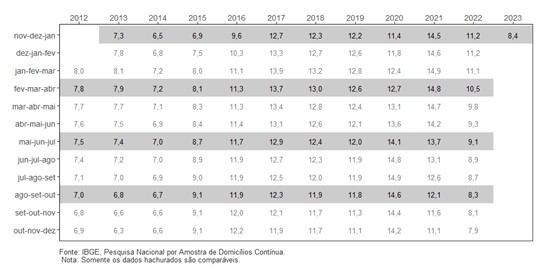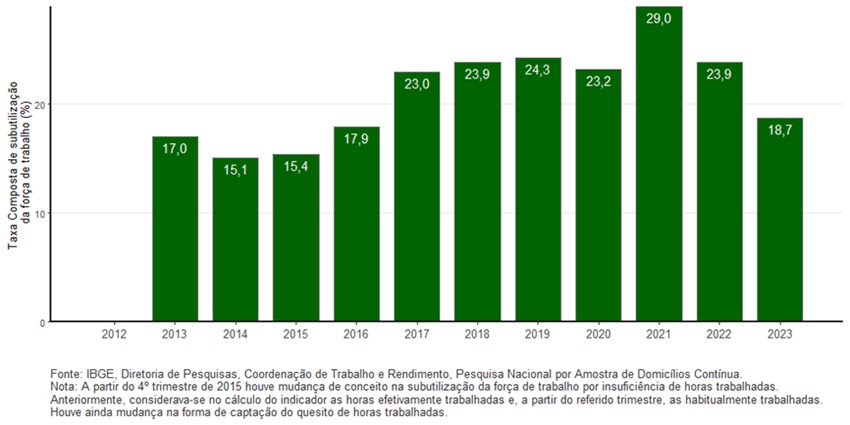Continuous PNAD: unemployment rate is 8.4%, underutilization rate is 18.7% in quarter ending in January
March 17, 2023 09h00 AM | Last Updated: March 20, 2023 04h54 PM
The unemployment rate (8.4%) in the moving quarter from November 2022 to January 2023 remained stable against the quarter between August and October 2022 (8.3%) and dropped 2.9 percentage points (p.p.) over the same period in the previous year (11.2%). This is the lowest unemployment rate for that period since the quarter ended in January 2015 (6.9%).
| Indicator/Period | Nov-Dec-Jan 2023 | Aug-Sep-Oct 2022 | Nov-Dec-Jan 2022 |
|---|---|---|---|
| Unemployment rate | 8.4% | 8.3% | 11.2% |
| Underutilization rate | 18.7% | 19.5% | 23.9% |
| Usual real earnings | R$2,835 | R$2,790 | R$2,633 |
| Change of usual earnings in relation to: | 1.6% | 7.7% | |
The unemployed population (9.0 million persons)remained stable against the previous quarter and dropped 25.3% (less 3 million persons) in the annual comparison.
The employed population (98.6 million) reduced 1.0% (less 1 million persons) against the previous quarter and rose 3.4% (more 3.2 million) in the year.
Estimated at 56.7%, the employment-population ratio - percentage of employed persons in the population at working age - dropped -0.7 p.p in the quarter and rose 1.3 p.p in the year.
The composite underutilization rate (18.7%) retreated -0.8 percentage points in the quarter (19.5%) and fell 5.2 p.p. in the year (23.9%). The underutilized population (21.5 million persons) dropped 5.2% over the previous quarter and 22.5% in the annual comparison.
The time-related underemployed population (5.2 million persons) dropped 12.6% (less 754 thousand persons) in the quarter and 24.4% (less 1.7 million persons) in the year.
The population outside the labor force (66.3 million persons) grew 2.2% against the previous quarter (more 1.4 million persons) and 2.2% in the annual comparison (more 1.4 million).
The discouraged population (4 million persons) fell 5.3% over the previous quarter (less 220 thousand persons) and 16.7% in the year. The percentage of discouraged workers in the workforce or discouraged population (3.5%) remained stable in the quarter and retreated 0.7 p.p. in the year.
The number of workers with a formal employment contract in the private sector (except domestic workers) amounted to 36.8 million persons, remaining stable in the quarter and growing 6.5% (more 2.3 million persons) in the annual comparison.
The number of persons employed without a formal contract in the private sector (13.1 million) remained stable against the previous quarter and grew 5.9% (725 thousand persons) in the year.
The number of self-employed workers (25.3 million) fell remained stable over the previous quarter and in the annual comparison.
The number of domestic workers (5.9 million persons) remained stable. against the previous quarter, but rose 4.7% (more 262 thousand persons) in the year.
The number of employers (4.2 million persons) dropped 4.1% (or less 179 thousand persons) compared to the previous quarter and remained stable in the annual comparison.
The number of employees in the public sector (11.8 million persons) fell 4.0% compared to the previous quarter and grew 3.9% in the annual comparison (more 447 thousand persons).
The informality rate was 39% of the employed population (or 38.5 million informal workers) against 39.1% in the previous quarter and 40.4% in the same quarter of 2022.
Usual real earnings (R$2,835) increased 1.6% in the quarter and 7.7% in the year.
The usual real wage bill (R$275.1 billion) remained stable against the previous quarter and increased 11.9% in the annual comparison.

Estimated at 107.8 million persons in the moving quarter from November 2022 to January 2023, the workforce (employed and unemployed persons) reduced 1.0% (less 1 million persons) compared with the quarter between August and October 2022, and remained stable against the same quarter last year.
Among the activity groups, Lodging and food (3.0% or more 156 thousand persons) increased in the quarterly comparison. Agriculture, livestock, forestry, fishery and aquaculture (-3.1% or less 272 thousand persons) and Public administration, defense, social security, education, human health and social services (-1.9% or less 342 thousand persons) reduced, whereas the other groups remained stable.
In the annual comparison, Trade, repair of motor vehicles and motorcycles (3.5% or more 637 thousand persons), Transportation, storage and mailing (9.8% or more 481 thousand persons), Information, communication and financial, real estate, professional and administrative activities (4.8% or more 544 thousand persons), Public administration, defense, social security, education, human health and social services (5.3% or more 876 thousand persons), Other services (8.8% or more 430 thousand persons) and Domestic services (4.4% or more 249 thousand persons) rose. Agriculture, livestock, forestry, fishing and aquaculture retreated (-4.5% or less 398 thousand persons).

The average usual real earnings (R$2,835.00) against the previous moving quarter grew in the following categories: Lodging and food (7.0% or more R$123), Public administration, defense, social security, education, human health and social services (3.1% or more R$121) and Domestic services (2.2% or more R$23). The other groups did not record significant changes.
In the annual comparison, Agriculture, livestock, forestry, fishing and aquaculture (11.7% or more R$192), Industry (7.1% or more R$181), Construction (8.5% or more R$177), Trade, repair of motor vehicles and motorcycles (6.9% or more R$148), Transportation, storage and mailing (4.9% or more R$125), Lodging and food (9.5% or more R$164), Information, communication and financial, real estate, professional and administrative activities (9.0% or more R$338), Public administration, defense, social security, education, human health and social services (4.9% or more R$187), Other services (9.6% or more R$194) and Domestic services (6.5% or more R$66) increased.
Among the employment types, Domestic workers (2.2% or more R$23) and Self-employed workers (3.9%) or more R$86) increased in the quarterly comparison. The other categories did not record significant changes.
In the annual comparison, Workers with a formal contract (5.0% or more R$126), Workers without a formal contract (12.2% or more R$206), Domestic workers (6.5% or more R$66), Workers in the public sector (including statutory officials and the military) (4.1% or more R$169), Employers (10.3% or more R$657) and Self-employed workers (11.3% or more R$233) increased.

